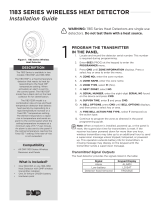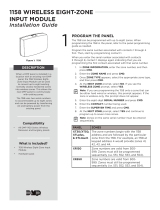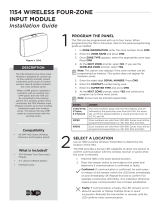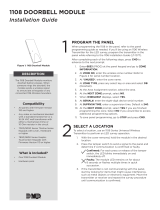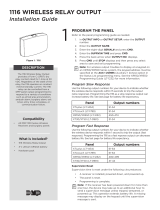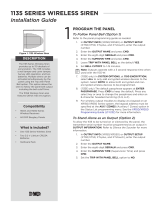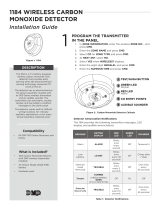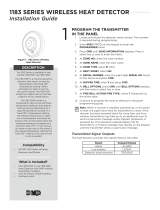
1136 WIRELESS REMOTE CHIME
Installation Guide
DESCRIPTION
The 1136 Wireless Remote Chime is
a multi-function sounder that plugs
directly into a standard 110 VAC wall
outlet.
The 1136 provides extra
annunciation in installations that
benefit from a louder keypad chime,
or small applications where no
keypad is installed and the system
is controlled from an app.
The 1136 annunciates Chimes (Zone
Monitor), as well as Entry Delay, Exit
Delay and Alarm messages.
Compatibility
• All DMP 1100 Series Wireless
Receivers and burglary panels
What is Included?
• 1136 Wireless Remote Chime
1PROGRAM THE PANEL
The 1136 is programmed in the panel as a wireless output. Refer to
the panel programming guide as needed.
If a wireless keypad is used, the 1136 will follow the first wireless
keypad that was added and sound with the keypad. If a hardwired
keypad is used, the 1136 will follow the first hardwired device on the
system and sound with the keypad.
For panels with Version 171 firmware or below, there must be a
wireless keypad installed on-site and programmed into the system
for the 1136 to sound with the keypad.
1. In OUTPUT INFO (XR Series) or OUTPUT SETUP (XT Series
and XTL Series), enter the OUTPUT number. For the first
1136 added to a system, use the following output numbers:
Panel First Output
Number
Additional Output
Numbers
XT Series 34 31-33 and 41-44
XTL Series 54 51-53 and 61-64
XR Series 453 450-452, 454-474, and 480-499
2. Enter the OUTPUT NAME.
3. Enter the eight-digit SERIAL# and press CMD.
4. Enter the SUPRVSN TIME (Supervision Time) and press CMD.
5. Select NO when TRIP WITH PANEL BELL displays. Selecting
NO will allow the device to listen for keypad messages to
sound instead of bell options.
6. Press the back arrow when OUTPUT SETUP displays.
7. For XR systems that need to send trouble notifications
about the Chime, see Additional Programming below.
8. Press CMD until STOP displays and then press any top row
select key or area to save and exit programming.
Figure 1: 1136
2The 1100 Wireless Series provides a Survey LED capability on most
transmitters to allow one person to confirm communication with
the wireless receiver or panel while the cover is removed.
This device does not have the Survey LED functionality so use
either an 1101 Universal Transmitter or 1106 Universal Transmitter to
perform the following test to select a good location for the 1136.
1. With the cover removed, hold the transmitter in the exact
desired location.
2. Press the tamper switch to send data to the panel and
determine if communication is confirmed or faulty.
Confirmed: If communication is confirmed, for each
press or release of the tamper switch, the LED blinks
immediately on and immediately o. Repeat this test to
confirm five separate consecutive LED blinks. Any
indication otherwise means proper communication has
not been established.
Faulty: If communication is faulty, the LED remains on
for about 8 seconds or flashes multiple times in quick
succession. Relocate the transmitter until the LED
confirms clear communication.
Note: If the DMP-recommended survey tests cannot be
followed, see Test the 1136 below for more details.
SELECT A LOCATION
Additional Resources
• XR150/XR550 Programming
Guide (LT-1232)

Designed, engineered, and
manufactured in Springfield, MO
using U.S. and global components.
LT-1669 22173
1136 WIRELESS REMOTE CHIME
Specifications
Frequency Range 905-924 MHz
Color White
Housing Material Flame retardant ABS
Dimensions 2.6 in W x 5 in H x 1.5 in D
6.6 cm W x 12.7 cm H x 3.8 cm D
Certifications
FCC Part 15 Registration ID CCKPC0193
Industry Canada Registration ID 5251APC0193
Patents
U.S. Patent No. 7,239,236
INTRUSION • FIRE • ACCESS • NETWORKS
2500 North Partnership Boulevard
Springfield, Missouri 65803-8877
800.641.4282 | DMP.com
FCC INFORMATION
This device complies with Part 15 of the FCC Rules. Operation is subject to the following two conditions:
1. This device may not cause harmful interference, and
2. this device must accept any interference received, including interference that may cause undesired operation.
The antenna used for this transmitter must be installed to provide a separation distance of at least 20 cm (7.874 in.) from all persons. It must not be located or operated in conjunction
with any other antenna or transmitter.
Changes or modifications made by the user and not expressly approved by the party responsible for compliance could void the user’s authority to operate the equipment.
Note: This equipment has been tested and found to comply with the limits for a Class B digital device, pursuant to part 15 of the FCC Rules. These limits are designed to provide
reasonable protection against harmful interference in a residential installation. This equipment generates, uses and can radiate radio frequency energy and, if not installed and
used in accordance with the instructions, may cause harmful interference to radio communications. However, there is no guarantee that interference will not occur in a particular
installation. If this equipment does cause harmful interference to radio or television reception, which can be determined by turning the equipment o and on, the user is
encouraged to try to correct the interference by one or more of the following measures:
1. Reorient or relocate the receiving antenna.
2. Increase the separation between the equipment and receiver.
3. Connect the equipment into an outlet on a circuit dierent from that to which the receiver is connected.
4. Consult the dealer or an experienced radio/TV technician for help.
INDUSTRY CANADA INFORMATION
This device complies with Industry Canada Licence-exempt RSS standards. Operation is subject to the following two conditions:
1. This device may not cause interference, and
2. this device must accept any interference, including interference that may cause undesired operation of the device.
This system has been evaluated for RF Exposure per RSS-102 and is in compliance with the limits specified by Health Canada Safety Code 6. The system must be installed at a minimum
separation distance from the antenna to a general bystander of 7.87 inches (20 cm) to maintain compliance with the General Population limits.
Le présent appareil est conforme aux CNR d’Industrie Canada applicables aux appareils radio exempts de licence. L’exploitation est autorisée aux deux conditions suivantes:
1. l’appareil ne doit pas produire de brouillage, et
2. l’utilisateur de l’appareil doit accepter tout brouillage radioélectrique subi, même si le brouillage est susceptible d’en compromettre le fonctionnement.
L’exposition aux radiofréquences de ce système a été évaluée selon la norme RSS-102 et est jugée conforme aux limites établies par le Code de sécurité 6 de Santé Canada. Le système
doit être installé à une distance minimale de 7.87 pouces (20 cm) séparant l’antenne d’une personne présente en conformité avec les limites permises d’exposition du grand public.
© 2022
4TEST THE 1136
After the 1136 has been programmed and plugged in to an outlet, test the 1136 to confirm that it is
communicating clearly with the panel. Use the Tech APP™ to perform a Sensor Test on the system, or follow
these steps to perform a Wireless Check-in Test from a keypad connected to the system:
1. At the keypad, enter 8144 (WALK) and select WLS.
2. If the 1136 fails to check in at the keypad, relocate it to a dierent outlet.
PLUG IN THE 1136
Use an outlet where the 1136 has good communication to the panel based on the results of the LED survey.
Caution: To reduce the risk of electric shock, do not remove or open the 1136’s cover.
3
ADDITIONAL PROGRAMMING
When using an XR Series Panel, to receive notifications that there is a trouble on the 1136, go to the AUX 1 ZONES in
Status List and enter in which keypad addresses you would like to receive notifications. See the Status List section of the
XR150/XR550 Programming Guide (LT-1232) for more information.
-
 1
1
-
 2
2



